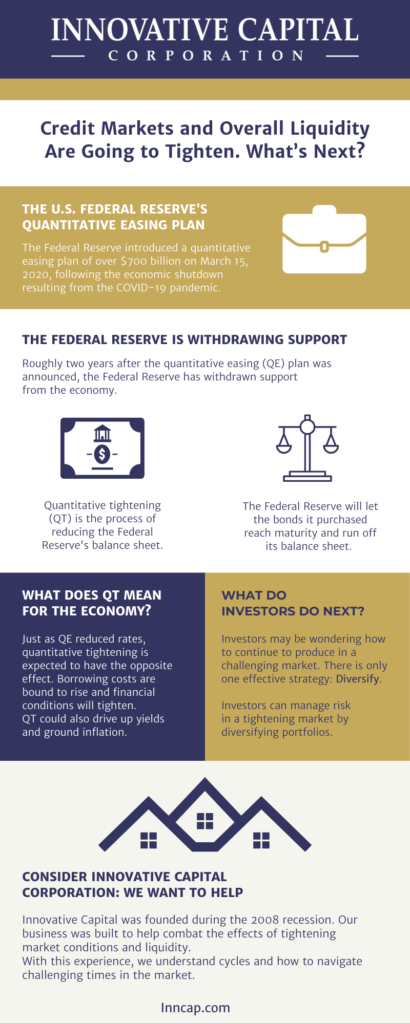On June 1, 2022, the Federal Reserve (the Fed) started quantitative tightening: The process of withdrawing its support from the U.S. economy. This process may cause interest rates to rise, inflation to decline, as well as an array of other effects.
All of these effects may leave investors wondering… What’s next?
Let’s dive into the details of the situation before exploring what investors should prepare for. To discuss quantitative tightening (QT), we first need to understand quantitative easing (QE).
What is Quantitative Easing?
In quantitative easing, a central bank buys long-term securities, like bonds. These purchases reduce long-term interest rates and add money into the economy.
The goals of QE are to encourage investment and spur economic activity. Additionally, quantitative easing expands the central bank’s balance sheet.
The U.S. Federal Reserve’s Quantitative Easing Plan
The Federal Reserve announced a plan following the economic shutdown resulting from the COVID-19 pandemic. On March 15, 2020, the Federal Reserve introduced a quantitative easing plan of over $700 billion. On June 10, 2020, the Fed extended its program until further notice.
These expansions included committing to purchasing at least:
- $80 billion a month in Treasuries, and
- $40 billion in mortgage-backed securities
The Federal Reserve is Withdrawing Support
Roughly two years after the QE plan was announced, the Federal Reserve has begun to withdraw support from the economy.
According to The Washington Post, the most delicate aspect of withdrawing support from “the biggest and broadest monetary-stimulus campaign in modern history,” will be shrinking its record balance sheet. This process is called quantitative tightening.
What is Quantitative Tightening?
In its simplest terms, quantitative tightening is the process of reducing the size of the Federal Reserve’s balance sheet (i.e. its assets and liabilities).
Why is Quantitative Tightening a Delicate Process?
The Federal Reserve doesn’t have a successful track record when it comes to quantitative tightening. In fact, the Fed has only tried QT once—in 2018. This attempt did not go well for markets.
According to Business Insider, “stocks fell sharply in 2018… the S&P 500 dropping more than 6%. After about 10 months, the central bank reversed the policy…
“QT on this scale has never been attempted before. From May 2022 to May 2023, the four biggest central banks – the US, eurozone, UK, and Japan – are expected to reduce their balance sheets by $2 trillion. That’s four times more than in 2018.”
How Will Quantitative Tightening Occur?
The Federal Reserve will let the bonds it purchased reach maturity and run off its balance sheet.
The U.S Department of the Treasury “then ‘pays’ the Fed at the maturity of the bond by subtracting the sum from the cash balance it keeps on deposit with the Fed,” according to the Washington Post. This will make the money the Fed put into the market “disappear.”
What Does Quantitative Tightening Mean for the Economy?
Just as quantitative easing reduced rates, qualitative tightening is expected to have the opposite effect. Borrowing costs are bound to rise and financial conditions will tighten.
QT could also drive up yields and ground soaring inflation; although these results can be influenced by other factors as well.
What Should Investors Do Next?
Investors may find themselves feeling uneasy during this time, concerned that QT might worsen market conditions—and understandably so. After all, the Fed doesn’t have an excellent track record when it comes to slashing their balance sheets or QT.
Investors may be wondering how to survive and continue to produce in a challenging market. At Innovative Capital Corporation, we think there’s only one effective strategy: Diversify.
Diversify, Diversify, Diversify
Investors can manage risk in a tightening and/or challenging market by diversifying their portfolios. We believe the next 36 months will provide opportunities for investors who play their cards right.
It’s time to prepare for the next opportunity.
Consider Innovative Capital Corporation

We—a team of real estate investors who love buying, rehabbing, and lending—want to help you. At Innovative Capital, we have liquidated the majority of our positions. Check out our recently funded loans!
We’ve Already Experienced a Market Crash
Innovative Capital was founded during the 2008 recession, which means for the last 20 years, we’ve been through the ups and downs of the market.
Our business was built to help combat the effects of tightening market conditions and liquidity.
We Provide Solutions
Our team is ready to work with investors to craft out-of-the-box solutions. For instance, we are prepared to cooperate on:
- Commercial Lending
- Private Capital
- Factoring
- Business Debt
- Foreclosure bailouts
- Purchasing debt
Depending on the unique needs of our clients, we have a lending solution. Please reach out if you’re interested in a free quote. Or, read on to learn the answers to all your questions about alternative lending options, such as: Who will give me a loan when no one else will?


